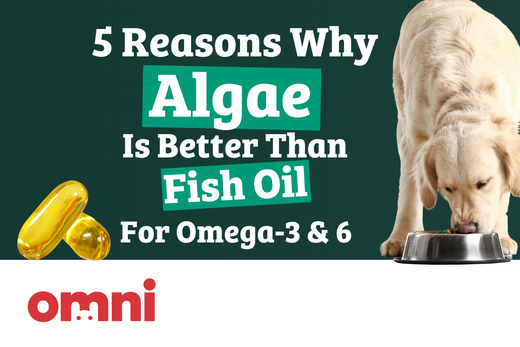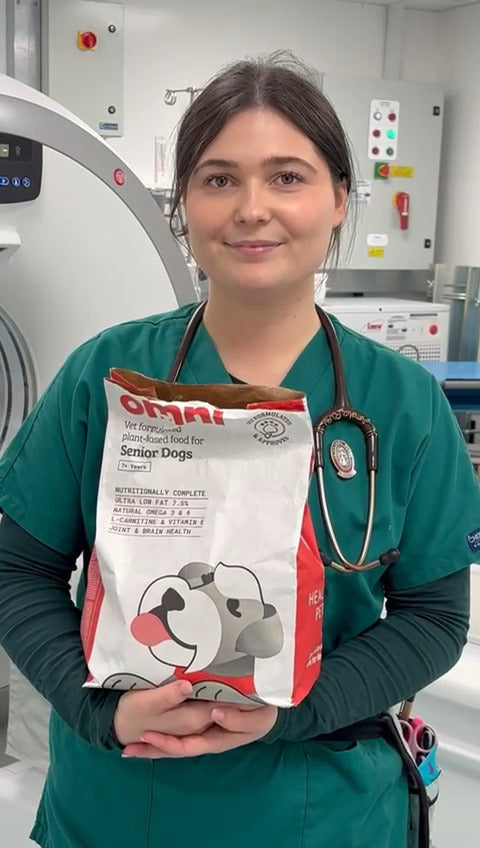5 Reasons Why Algae Is Better for Omega-3 and Omega-6 than Fish Oil For Your Dog

A lot of people wonder whether fish oil is the best source of omega-3 and omega-6 and how omegas derived from algae stack up in comparison.
The truth is, algae derived omega 3 and 6 are not only just as effective, but they are demonstrably better for your dog than fish-based omega 3 and 6!
In this article, we’ll explore exactly what Omega-3 and Omega-6 are, what they do, how to get them, and why you should choose an algal source of Omega supplements for your dog.
What is Omega-3?
Omega-3 is an important nutrient that is essential for proper functioning in both dogs and humans.
A common kind of polyunsaturated fatty acid, omega-3 is made up of carbon, oxygen, and hydrogen atoms in a combination that neither humans nor dogs can directly produce.
Dogs need omega-3 to ensure the proper functioning of their heart, brain, and eyes - and it’s just as important for human bodies, too!
Omega-3’s are categorised as EPA (eicosapentaenoic acid), DHA (docosahexaenoic acid), or ALA (alpha-linoleic acid).
What is Omega-6?
Omega-6, like Omega-3, is an essential fatty acid that dogs cannot produce themselves which are essential for your dog’s immune system and skin and fur health in particular.
Depending on the exact chemical structure, Omega-6 can be either LA (linoleic acid) and GLA (gamma-linoleic acid).
Where Do Dogs Get Omega-3 and Omega-6 From?
Omega-3 and Omega-6 can either be supplemented or found in the ingredients of your dog’s food - or both.
- Omega-3 ALA can be found in oils like flaxseed and canola oil.
- Other types of Omega-3, EPA and DHA, are found in cold water fish like salmon, extracted salmon oil, phytoplankton and underwater (marine) plants and algae. ALA can also be converted into EPA and DHA, but relatively ineffectively.
- LA is found in some meats and fish oils, as well as soya products (tofu included!), hemp seeds, sunflower seeds, peanut butter, avocado oil, almonds, cashews, and more.
- GLA can be converted from LA, as long as your dog has enough magnesium, zinc, vitamin C, vitamin B3 and vitamin B6. Alternatively, GLA can be found in many plant oils and algae like spirulina.
How Much Omega-3 and Omega-6 Do Dogs Need? (And How Much Are They Getting?)
Typically the amounts of Omega-3 and 6 that your dog needs vary by age and size, although it typically is around 75–100mg per kilogram of body weight (kg) per day for Omega-3..
This means, for instance, that a 30kg dog should be getting around 2.25-3g of Omega-3 per day, and a 5kg dog should be getting 0.38-0.5g per day.
You usually need to give your dog 2-6x more Omega-6 than Omega-3.
Thus, a 30kg dog should get between 4.5-18g of Omega-6 per day, and a 5kg dog should get 0.75-3g of Omega-6 per day.
This ratio of 2-6:1 Omega-6:Omega-3 is very important for dogs. Many dogs get as much as 25x more Omega-6 than Omega-3, meaning a ratio of 25:1!
As we’ve discussed elsewhere, imbalances of nutrients like this can cause a series of health issues in your dog.
Why Is Algae a Better Source of Omega-3 and Omega-6 than Fish Oil?
1. Algae Make Omegas (While Fish Just Get Them From Algae)
It’s true: fish only get their Omega-3’s and 6’s from eating underwater plankton and algae anyway, so it’s best to go straight to the source - that is, marine algae - to give our dogs the best quality Omegas we can!
2. Algae Omegas Are More Bioavailable Than Fish Oil Omegas
‘Bioavailability’ is a concept denoting the absorbability of a nutrient. Some foods or supplements have low bioavailability, meaning the body cannot easily absorb the right nutrients. Higher bioavailability is therefore a good thing - and algae is super bioavailable!
For the science boffins, this is because algal oil contains unmodified triglycerides, which are more bioavailable than the ethyl ester forms found in refined fish oil.
Ultimately, this just means your dog gets a better service from algae omegas than fish oil-based omegas.
3. Fish Oil Is Unpalatable to Many Dogs (And People!)
Fish oils and fish-containing products often have a distinctive ‘fishy’ smell that can be off putting for both dogs and people! Algae-based products are far more neutral and palatable, meaning your dog is more likely to wolf down all the nutrients they need, no questions asked.
4. Algae-Based Omegas Have More Omega-3’s
As we mentioned above, that ratio of Omega-3 to Omega-6 is really important. Typically Omega-3 is in short supply in both human and canine diets.
Algae-based products typically have more Omega-3’s than fish oil-based products do, although numbers vary.
This is ideal if you are concerned about increasing the amount of Omega-3 your dog gets, which is the crucial part of the equation. Omega-6’s are abundant and probably don’t need to be worried about in most cases.
5. Algal Products Are More Sustainable
It is far easier, cheaper, and more sustainable to harvest Omega-3’s from algae than from fish.
You may have heard that biodiversity is dropping significantly in the oceans as more species of fish than ever are under threat of extinction.
Most of this is due to climate change and overfishing by humans - so it is about time we switched over to more effective and sustainable sources of Omegas like algae oil!
Thoughts from Dr Guy MRCVS
As dog lovers and guardians, it’s natural to worry about our furry friends, especially when they display abnormal symptoms that can’t be easily explained. That’s why, when I founded Omni, I knew that I wanted to keep vet consultation free and accessible at the heart of the business.
If you’re understandably worried about your dog, but you don’t think you need to take them to the vets urgently, I highly recommend getting some friendly, professional advice from one of our team.
Disclaimer: Our Video Vet Consultation service is limited because we are unable to perform a full physical examination of your pet. Our vets have no responsibility for the examination or other medical services provided during the Consultation.
Please note that our Video Vet Consultations do not replace traditional veterinary care, but can provide additional support. Based on the information you have provided and the symptoms you have described, the Vet will give you advice and an ongoing plan. Without a physical examination, we cannot provide a definitive diagnosis. If you are worried that your dog's condition is worsening, or you need additional support, please schedule another consultation, or see your registered vet.







 85 Great Portland Street, 1st Floor, London, W1W 7LT United Kingdom
85 Great Portland Street, 1st Floor, London, W1W 7LT United Kingdom